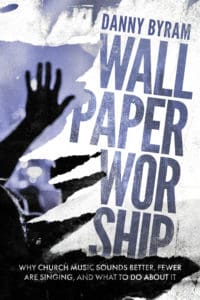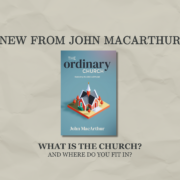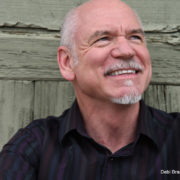Five Ways Your Church Can Avoid Wallpaper Worship
By Danny Byram, author of Wallpaper Worship: Why Church Music Sounds Better, Fewer Are Singing, and What to Do About It
So, what is wallpaper worship? It is very easy to spot. Just walk into a church, grab a coffee, and find a seat. When the music starts, you are free to sit and sip, stand and watch, roam the sanctuary, find someone to visit with (if the volume allows), or skip it altogether and get a coffee refill in the lobby. Wallpaper worship is the religious equivalent of music in a store or a dentist’s office. It is great music, but it is not designed for participation. Wallpaper worship is meant to simply be listened to or observed as it is performed. Worshippers who come to participate are not actually able to because it sounds so good, so slick, so produced, and so well-performed that you don’t want to mess it up by actually singing along with it. The vibe communicated from the platform is “Just sit back and relax; we’ll do this for you.”
In his classic book Worship is a Verb, Robert E. Webber states, “[Worship] is not something done to us or for us, but by us.” Webber’s view, like the view of so many frustrated worshippers today, was founded upon a principle that was at the heart of the sixteenth-century Reformation. That principle touted a new and radical idea: Believers should be able to express their beliefs and their worship of God freely, openly, and corporately without any priests or clergy doing it for them. Today we are in a pre-Reformation cycle of wallpaper worship. Our ability to perform music and speak publicly has become so formulaic that church has become akin to a museum or concert hall. All you have to do is show up and assume the role of an audience.
Here are five ways your church can avoid the common trap known as wallpaper worship. (Some of what I have written is to leaders and some to those being led. Feel free to pass these five principles along as is appropriate for your situation.)
- Cast a vision. Church leaders need to decide what kind of church they will lead. Will yours be a typical wallpaper worship church, or will you make the changes necessary to encourage, facilitate, and promote participation? To simply say the church wants congregants to participate will never accomplish it. Specific changes need to occur from the church leadership in order to bridge the gap between the people and the platform. Many worshippers have experienced the discouragement of trying to articulate to leaders their desire for change, only to be dismissed as out of touch. For instance, one church I know trains their ushers to hand out earplugs if people come to the lobby to complain about the volume of the “show.” One of the leaders of that church made it clear to me that if people don’t like it, they can find the door. Casting a vision for participation involves more than lip service. It takes sincere action to gently bring congregants into the fold of participation. An attitude from leaders of “It’s not our fault if they don’t participate” is a cop-out and a justification for wallpaper worship. If you’re part of a church that refuses to cast a vision for participation, then find one that will.
- Use your binoculars. When I was producing and directing the Promise Keepers stadium events for men (events that filled NFL-sized stadiums around the nation in the mid-1990s), it was difficult to know if the attendees in the upper sections at the far end of the stadium were connecting with what was happening on the platform. From the opposite end of the stadium, the platform looked like the size of a postage stamp. I would step out from the stage side producer’s tent and look through binoculars to spot those in the far-off upper section seats to see if they were as engaged as the men sitting in chairs on the field in front of us. If we were losing participants from music or a speaker that was not engaging, we would change what we were doing until we saw 100 percent participation. Only by looking through “binoculars” can one see to what degree a platform is or is not connecting with those it is supposed to be leading. Proverbs 27:23 says, “Know well the condition of your flocks.” Pay attention. If people are not participating, the effectiveness of the leadership is questionable.
- Try painting in more than one color. Have you ever been to an art exhibit or a museum where all the paintings are in one color? How tedious would it become to view paintings throughout galleries and hallways that are exclusively in blue? When we plan and execute worship services in one narrow style, we are painting in one color. Try using a capella. Calm down the instruments and let the people sing and hear themselves sing. Try using a responsive reading where people hear their voices reciting Scripture aloud and in unison. Try an unplugged, acoustic set of music once or twice a month. Try using a live, classical, sacred piece somewhere appropriate to your service order or content. Why does everything have to be one style, one sound, one means of expression? Music listeners of all ages today access more styles and cultures of music than ever before through Pandora, Spotify, and YouTube. But in today’s church, only one style seems to be allowed. The colors of the artist’s palette are many. Try painting with more than one.
- Earn the trust. I once read on a popular worship blog, “The more they sing with you, the more they will trust you.” My experience with producing large and small worship events for decades is the opposite: The more they trust you, the more they will sing with you. Congregants are conditioned by the culture of the church. If the people in the pews sense the worship service is simply a performance to be observed, they will be reluctant to participate—even if given the chance in an a capella song. Leaders need to earn the trust of those they lead. Trust is earned over time by casting a vision for participation and letting congregants hear themselves; it is even earned in the unplanned ambiguity of following the Spirit’s leading.
- Be familiar. There is more worship music being written and released today than ever before. Most of it is unfamiliar, even to the select people who listen to Christian radio stations in their cars every day. Musicians tend to think they need to be teaching or performing all the latest material. This is a ruse and it leads to nonparticipation. The more that is new, the less they will know. Do the new stuff, but also use familiar songs that are dear to congregants young and old—songs and worship elements that have stood the test of time and personal devotion. Most of what is heard today will not be around two years from now. A gracious and trusted shepherd leads the sheep with a familiar rod and staff. Leaders have an obligation not only to lead the sheep beside still waters but to actually let them drink. They will be comforted knowing that their shepherd has their best interests in mind. Trust will result. Participation will follow.
Throughout history, wallpaper worship has cycled in and out. It thrives in times of prosperity but disappears in times of struggle or persecution. Whether you are a leader or a worshipper being led, it is time to bridge the gap between the platform and the people. Worshippers today are frustrated when they are not led in worship and feel they are being used as an audience. But take courage: When the bride is frustrated, the Bridegroom pays attention. “The hour is coming, and is now here, when the true worshipers will worship the Father in spirit and truth, for the Father is seeking such people to worship Him” (John 4:23).
Danny Byram teaches a one-day workshop called “Wallpaper Worship Removal: The Tools and Tips for Encouraging a Participating Congregation.” Book a workshop by contacting db*****@***il.com.
ABOUT

Danny Byram is an independent Christian recording artist and worship leader who has performed on five continents. Known by US military chaplains as “The Combat Musician,” Danny has given outreach concerts for the United States military community on over one hundred installations since 1987. He also produced and directed the Promise Keepers stadium events and the FamilyLife marriage arena events. With his breadth of experience in worship, performing arts and leadership, he lectures and conducts workshops on worship in colleges, churches, and military chapels throughout the world.
Follow Danny

In Wallpaper Worship, Daniel Byram makes the comparison between today’s church worship and wallpaper—meant to emphasize the design of its surroundings, but not meant to be engaged with. Through an examination of personal worship experiences, the history of worship, and examples of biblical worship, Byram unpacks this analogy. He shares how to awaken our identities as corporate and individual worshippers, and passionately participate in the God-ordained activity of worship.
Wallpaper Worship is now available! Get your copy here.













Hey Danny – we met back in 2004 or 2005 when I visited your church – Peter Hiett was your pastor at the time. We led worship once together at the church. I think I remember having conversations with you regarding this topic – I’ve had this conversation with anyone who’ll listen for decades! It was one reason my wife and I grew together – talking and sharing about our mutual frustration re: the worship performance phenomena – an oxymoron if ever there was one!
Your points are all valid – the music is meant to be a vehicle for worship, not an end in itself. The problem I’ve seen, and I do remember talking with you re: this is that the whole physical setup of the service helps create the performance problem – the musicians are on stage! Front and centre! The modernization church movement – removing icons, symbols, ‘decorations’ – which were meant to visually lift the congregants out of their world of earthly poverty, and into an atmosphere/ a sense of royalty/ in the presence of the king, has instead placed the church into a context of neutrality / sterilization. Churches are now warehouses, and the focus of the eye is a stage – on that stage? The musicians. I make no assessment/judgment of the hearts of the musicians – but the context allows for a vulnerability towards performance and pride. The lights are on them – the eyes are on them. The cross used to ‘on stage’ – now it’s the skinny jeaned, facial-follicle-ly challenged music-‘leader’ in the spotlight.
I don’t actually advocate for a return to high church with its symbology – one doesn’t need extravagance in monetary expenditure for church trappings when funds could be better directed to evangelistic AND discipleship endeavors. Having said that, church funds previously spent on ’decorations’ are still spent on that, except modern decorations look more like professional industry sound and light systems, and significant sized salaries for the large staff numbers that operate their respective churchy-looking businesses.
The modern music movement in churches has also let in the door the worship of emotions. “Hey Sally … how was church today? did you enjoy the music?” … wait … since when has our enjoyment of the music become the yardstick to measure the validity of worshipping God? I’d add that I believe the most effective music used to worship God is that which seems invisible after the fact – it doesn’t stand out, as it doesn’t strive to stand out. I’m looking at you lead guitarists! A vehicle is not a destination – it takes you to it, but doesn’t get in the way. Anyway, just some thoughts. Glad to see you’re challenging the powers-that-be. There is so much money invested in this notion of performance – CCM exists because of it!
Hey Shaner! Thanks for your chosen and well-articulated thoughts. Yup. Discussing all the issues surrounding this is like drinking from a fire hydrant. All I can say is, I am not called to debate worship – but just present what I’ve learned through the years. I can tell you, from what I see/hear in traveling, there is a movement of people within the church who “don’t buy it.” Many are in their 20s. Blessings to you! DB
I don’t like the “movie-star” concept either. When I hear the classics of each generation’s music, I can feel my whole spirit and soul rise up within me, and I know it is the true worship of the LORD
Hi Shane. I remember chatting about these issues. For me, it’s easier to pick t out the problems than it is to articulate the solutions. At this point let’s live in the moments we are given – worship in the settings in which we find ourselves, and do what Jesus said: watch and pray! Thanks for your valuable insights. Stay the course.
DB
I don’t like the “movie-star” concept either. When I hear the classics of each generation’s music, I can feel my whole spirit and soul rise up within me, and I know it is the true worship of the LORD